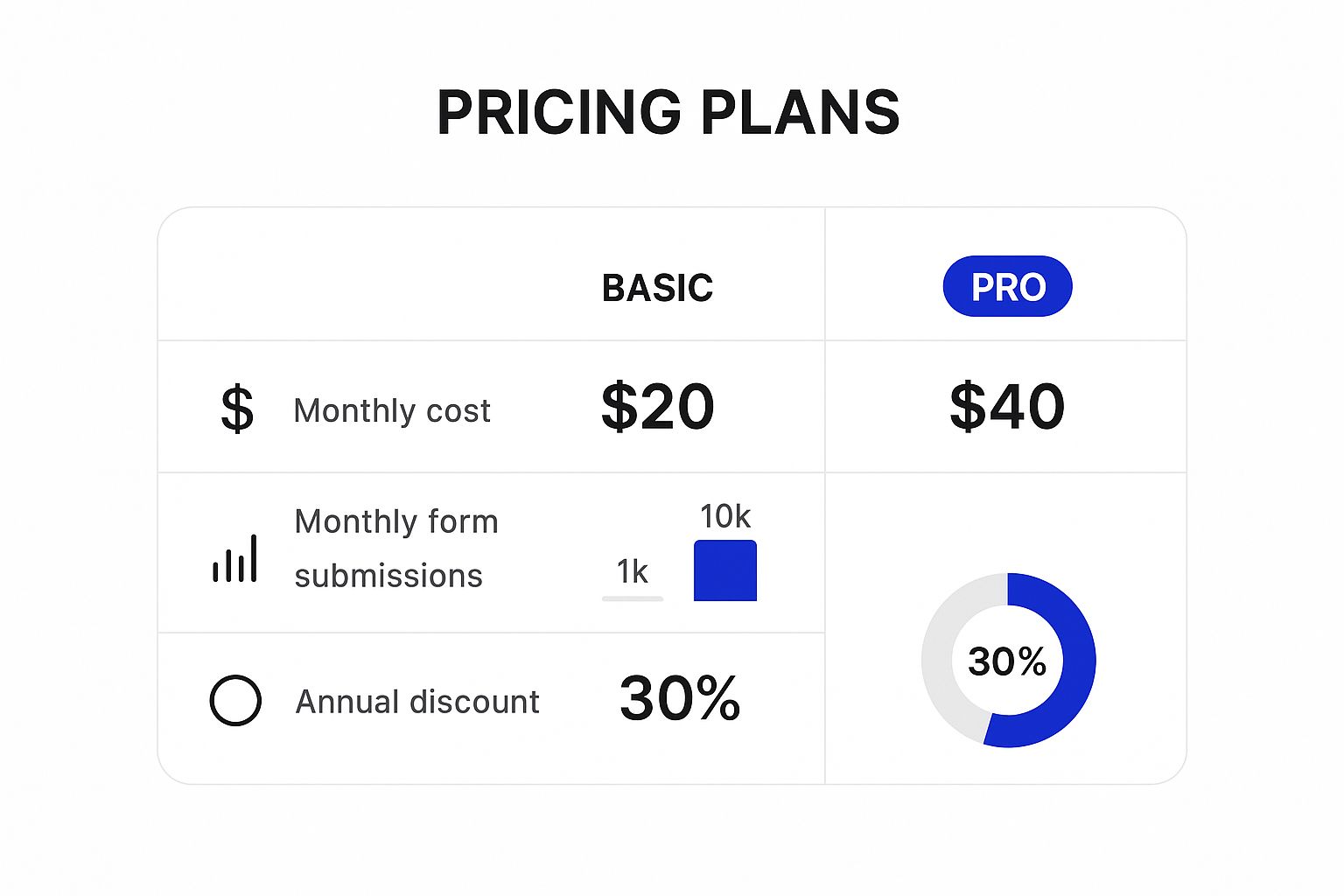Decoding Capterra Jotform Reviews for Your Business
Is Jotform right for you? This guide breaks down Capterra Jotform reviews, user feedback, and top features to help you make a smarter decision.

Trying to make sense of Jotform's presence on Capterra can feel overwhelming. You’re hit with thousands of reviews and countless data points, and it's tough to know where to even begin.
But this platform offers a genuine window into the user experience, completely unfiltered by marketing spin. If you know how to look, you’ll find everything you need.
Making Sense of Jotform on Capterra
When you first land on Jotform’s Capterra page, you're met with a wall of data. Sifting through it all is the first step toward making a smart software decision for your business. Think of Capterra as a trusted peer-review site, gathering feedback from verified users to show you how a tool performs in the wild.
The overall star rating is the first thing you'll see, and it gives you a quick snapshot of general satisfaction. The real value, however, is in the details that make up that score.
Jotform Capterra Scorecard At a Glance
To get a quick pulse on Jotform's performance, it helps to see the key metrics in one place. This table breaks down their Capterra profile, giving you an at-a-glance summary of what real users are saying.
This scorecard gives you a solid foundation, but the story doesn't end here. The individual reviews are where you'll find the context behind these numbers.
What the Numbers Really Mean
Aggregated reviews show that Jotform holds a fantastic satisfaction rating of about 4.6 out of 5 stars from over 2,100 verified users. That's a lot of happy customers.
The platform is widely praised for its drag-and-drop interface, with a whopping 94% of users calling it out as a key feature that makes form creation easy. Many customers say Jotform helps them streamline their day-to-day operations by cutting down on paperwork, all without needing to hire a technical specialist.
Still, it's not all perfect. Some users point out the limitations of the free plan's submission caps and mention occasional hiccups with payment processor integrations. Want to learn more about reading between the lines? Check out our detailed guide on interpreting Capterra reviews.
Common Problems Solved by Jotform
So, what are people actually doing with Jotform? Capterra reviews consistently show users turning to it to solve a few key business challenges:
- Simple Data Collection: This is its main purpose. Think basic contact forms, quick feedback surveys, and mailing list sign-ups.
- Complex Registration Systems: Users are also building much more detailed systems, like event registrations, multi-page application forms, and appointment booking flows.
- Automating Workflows: This is where things get powerful. People are connecting forms to their other business tools to automatically update spreadsheets, trigger notifications, and manage new leads.
This quick overview of the Jotform Capterra listing sets the stage for a deeper look, helping you see both the high-level praise and the specific details that matter most.
Why Millions Choose Jotform for Their Forms

Those high ratings on Capterra aren't just for show. They point to specific things people genuinely love about using Jotform, and one theme pops up again and again: it’s just plain accessible. It completely removes the technical walls that used to make building a simple online form feel like a job for a developer.
This user-friendly approach really comes down to two game-changing features: a truly massive template library and a ridiculously flexible network of integrations. These two things work together to turn what could be a headache into a simple, almost plug-and-play experience for just about any business out there.
Jumpstart Your Projects with Templates
We’ve all been there; staring at a blank screen is the quickest way to kill a project's momentum. Jotform gets this, which is why they offer a library packed with over 10,000 ready-made templates. This is not a handful of generic "contact us" forms. This is a deep, specialized collection built for countless industries and very specific needs.
Think about a small retail shop. They can instantly find templates for everything from managing inventory and collecting customer feedback to setting up online order forms. Having that starting point means they can get a new process up and running in minutes, not hours.
Imagine a non-profit that needs to quickly launch a volunteer sign-up and donation page for an urgent fundraising drive. Instead of wrestling with code, they can grab a pre-built template, add their logo and colors, and have it live before the end of the day.
This ability to get things done fast is a constant refrain in the Capterra reviews. Users absolutely love that they can find a professional, working form for almost anything they can think of, letting them get back to running their business instead of getting bogged down in tech.
Connecting Your Entire Workflow
A form builder is only as good as the tools it talks to. This is where Jotform really shines, offering hundreds of integrations that connect it to payment gateways, CRMs, cloud storage, and project management apps. This connectivity turns a simple form into the trigger for a completely automated workflow.
Take a school using Jotform for student applications, for instance. With the right integrations, a single submitted form could automatically:
- Create a new student profile in their database.
- Add the parent’s email to a newsletter list in Mailchimp.
- Ping the admissions team with a notification in a Slack channel.
This kind of automation is a huge time-saver and drastically cuts down on the risk of human error. It’s this powerful combination of easy-to-use templates and robust integrations that has helped Jotform grow to serve over 20 million users since its start in 2006, especially appealing to businesses that don't have a developer on standby. You can dig deeper into its journey in this overview of Capterra Jotform insights.
Using Jotform for Ecommerce and Payments
When you dig into the Capterra reviews for Jotform, a surprising theme pops up again and again. People don't just see it as a form builder. For tons of small businesses, it has become their go-to e-commerce platform for selling products and services directly.
This ability to turn a simple form into a revenue machine is a game-changer. It’s all thanks to a really solid set of commerce features that let you build a functional online store with zero coding. You can manage everything from listing products to collecting payments, all in one place.
Building Your Online Storefront
Getting started with Jotform's e-commerce tools is refreshingly simple. A big reason for this is their library of over 300 professionally designed online store templates. These aren't just basic layouts; they give you a polished, ready-to-go foundation for your store.
Once you pick a template, adding products, setting prices, and managing your inventory is a breeze. Jotform also connects with over 40 payment processors, including the big names like PayPal, Stripe, and Square. This flexibility is huge because it means you can stick with the payment gateway you already know and trust.
One feature that users constantly rave about is that Jotform does not charge additional transaction fees. For a small business trying to keep overhead low, this is a massive cost-saving benefit. If you want to dive deeper, they've got some great info about their e-commerce solutions on their blog.
The mix of user-friendliness, tons of payment options, and fee-free transactions is a big reason why Jotform maintains a stellar 4.7/5 user rating on sites like Capterra and G2, especially with entrepreneurs.
Automating Payments and Workflows
Taking one-time payments is just the start. Jotform’s payment tools are built to handle all sorts of sales models. You can easily set up forms to collect donations, sell tickets to an event, or even manage recurring subscriptions for your services.
That ability to handle subscriptions is particularly powerful for businesses with a recurring revenue model, like SaaS companies or membership sites. For a closer look at managing ongoing billing, resources on choosing a recurring payment processor can be incredibly helpful.
The real magic happens when you connect these payment features to Jotform's automation tools. After a customer buys something, you can trigger a whole series of follow-up actions automatically:
- Send a customized receipt and thank-you email without lifting a finger.
- Add the new customer's info straight into a CRM like Salesforce.
- Enroll the customer in an email marketing campaign through Mailchimp.
This level of automation, as many Capterra Jotform reviews point out, is a lifesaver. It frees up hours of manual work and cuts down on human error. It lets a small team, or even just one person, run a sales operation that feels professional and runs like a well-oiled machine.
Digging Into the Common Themes in User Reviews

Star ratings and overall scores on Capterra are great for a quick health check, but the real story is always woven into the thousands of individual reviews. When you start sifting through the Capterra Jotform feedback, you’ll notice clear patterns emerging pretty quickly.
These recurring comments, both good and bad, paint a much more textured and realistic picture of what it’s actually like to use the tool day-to-day. By grouping this feedback into common themes, we can get past simple praise or complaints and see the bigger picture. This helps you anticipate the tool's true strengths and potential frustrations, based on what countless others have already experienced.
What People Consistently Love
The positive feedback for Jotform tends to rally around a few core pillars that make the tool feel both powerful and approachable. These are the things users bring up again and again as game-changers for their workflow.
- The Drag-and-Drop Builder: Hands down, the most praised feature is the intuitive form builder. Users love that they can create professional, often complex, forms without touching a single line of code. This is huge because it allows non-technical team members to build exactly what they need on their own.
- Powerful Conditional Logic: A ton of reviews rave about the conditional logic. This feature lets your forms dynamically change based on a user's answers, creating a much smarter and more personal experience. For instance, the ability to show or hide questions based on a previous selection is a celebrated function.
- A Massive Feature Set: People are consistently impressed by the sheer breadth of what Jotform can do. From payment processing and appointment scheduling to e-signatures and PDF generation, the platform is often described as an all-in-one solution that eliminates the need for a bunch of separate tools.
Common Critiques and Sticking Points
Of course, no tool is perfect, and honest user reviews on Capterra are quick to point out where things could be better. These critiques are just as valuable as the praise because they flag potential hurdles you might run into yourself.
One of the most frequent complaints circles back to the free plan's limitations. While it's a generous starting point, the cap on form submissions (100 per month) and available storage can become a real barrier for growing businesses, often pushing them to upgrade sooner than expected.
Another recurring theme is the learning curve that comes with Jotform's more advanced features. While building a basic form is easy, really mastering things like complex calculations or tricky integrations can take some time and effort. Users occasionally mention specific struggles with getting certain third-party app connections to work just right.
Figuring out what users are really saying is a massive part of evaluating any software. If you want to get better at this, our guide can help you effectively analyze customer feedback to make smarter choices. By weighing both the celebrated features and the common frustrations found in Capterra Jotform reviews, you get the complete story, which is exactly what you need to pick a tool that truly fits your team’s needs.
How Jotform Compares to Other Form Builders
No tool exists in a bubble. While digging through Capterra Jotform reviews gives you a great sense of what users love (and don't), the real magic happens when you see how it stacks up against the competition. After all, choosing the right form builder often comes down to understanding the subtle but important differences between the big players.
You’ve got major contenders like SurveyMonkey, Typeform, and Google Forms, each with its own fan base and for good reason. The "best" choice really depends on what you're trying to accomplish. Are you building a beautiful, brand-forward quiz to engage your audience, or do you just need a quick-and-dirty form to collect internal feedback? Your specific goals will point you to the right platform.
Feature And Use Case Breakdown
Let's break these tools down by what they do best, because different scenarios call for different strengths. A marketing team obsessed with creating a seamless brand experience will prioritize slick design and customization. On the other hand, an operations manager might care more about powerful integrations that automate their workflows.
It really comes down to matching the tool to the task.
- For Brand-Centric Surveys: This is Typeform’s specialty. Its signature one-question-at-a-time flow feels more like a conversation than a form, making it a favorite for user engagement. If you want to see how it fares in user reviews, we have a whole guide breaking down Typeform on Capterra.
- For In-Depth Data Analysis: SurveyMonkey is the undisputed heavyweight champion of serious market research. It’s packed with advanced analytics, sentiment analysis, and reporting features that let you slice and dice data in ways most other form builders can't touch.
- For Cost-Free Simplicity: When you need a basic form without any fuss (or cost), nothing beats Google Forms. It integrates flawlessly with the Google Workspace ecosystem, making it the default choice for quick internal polls, simple event registrations, or basic contact forms.
- For All-Around Versatility: This is where Jotform really shines. It's the Swiss Army knife of form builders. With a massive library of templates, sophisticated conditional logic, payment processing capabilities, and a huge list of integrations, it can handle just about any job you throw at it.
You don't just have to take my word for it. This Capterra screenshot lays it all out, showing a head-to-head comparison between Jotform and other top-rated tools.

As you can see, Jotform consistently pulls high scores across the board for ease of use, features, and overall user satisfaction, proving it can hold its own against more specialized competitors.
Jotform vs Competitors Feature Comparison
To give you a clearer picture, let's look at a side-by-side comparison. This table breaks down how Jotform stacks up against SurveyMonkey and Typeform based on the features that matter most when you're making a decision.
Ultimately, the best tool is the one that fits your budget, your team's technical skills, and your primary goals. While Typeform wins on user experience and SurveyMonkey dominates data analysis, Jotform’s true strength is its incredible versatility. It’s built to adapt to whatever you need.
Using Capterra Reviews to Make Your Final Call
Alright, you've done the legwork. You've sifted through the scores, compared the features, and gotten a feel for the common praise and complaints in Capterra Jotform reviews. Now it's time to pull it all together and figure out if Jotform is the right tool for you.
The goal here isn't just to passively read reviews; it's to use them as a strategic tool to make a smart software decision for your business.
A great way to start is by using Capterra's filters. You can slice and dice the reviews by industry and company size, which is a fantastic way to find feedback from businesses that are a lot like yours. After all, a small marketing agency will use Jotform very differently than a large university, and their reviews will reflect that. This kind of targeted feedback is pure gold, way more useful than just looking at the overall score.
Look Beyond the Star Rating
Once you have a filtered, relevant set of reviews, it's time to dig deeper than the star rating. The real insights are in the details.
- Connect Features to Your Goals: If you see users raving about Jotform's advanced conditional logic, ask yourself: "Is that something that would solve a real problem for me right now?" If everyone loves the e-commerce integrations but all you need are simple feedback surveys, that feature probably shouldn't be your deciding factor.
- Weigh the Drawbacks Realistically: Pay close attention to the common complaints. Is the submission limit on the free plan a total deal-breaker for the volume you're expecting? If some users mention that the more advanced features have a learning curve, do you have someone on your team who's willing to dig in and learn, or do you need a tool that's dead simple right out of the box?
This infographic breaks down Jotform's pricing tiers pretty clearly, showing you the monthly cost, submission limits, and what you can save by paying annually.

As you can see, jumping to a Pro plan gives you a massive boost in submission capacity for a relatively small price increase, especially if you go with the annual discount. By carefully weighing the features people love against the potential drawbacks that actually matter to your workflow, you can move forward confidently and decide if Jotform is the right fit.
Frequently Asked Questions About Jotform
After digging through what feels like a mountain of Capterra Jotform reviews, you start to see the same questions pop up over and over again. Getting straight answers to these is key, because it helps you connect what real users are saying to what you actually need for your own business.
So, let's clear up some of the most common questions people have when they're sizing up Jotform.
What Is Jotform Primarily Used For?
At its heart, Jotform is an online form builder. But that’s a bit like saying a smartphone is just for calls. Capterra users are using it for just about everything you can imagine, from simple contact forms and customer feedback surveys to really complex event registrations and online applications.
It’s all about helping businesses pull in data, kick off automated workflows, and even handle payments, all without having to touch a single line of code.
Can Jotform Handle Appointment Scheduling?
Yes, it absolutely can, and this is a feature people rave about in the reviews. Jotform has some surprisingly solid scheduling tools built right in. You can create booking forms, block out your availability, and sync it all up with calendars you already use, like Google Calendar and Outlook.
This is a huge time-saver for businesses looking to automate their appointment-setting process.
For small businesses, this is a game-changer. Being able to roll client intake, booking, and even payment collection into one smooth, automated workflow means less time spent on back-and-forth emails.
Is Jotform Secure for Collecting Sensitive Information?
Security is always a big question, and Jotform takes it seriously. Every form is served over a secure 256-bit SSL connection, which is the industry standard.
On top of that, they offer HIPAA-compliant plans specifically for healthcare providers. This makes certain any sensitive patient data is locked down and protected according to strict regulations.
How Does the Free Plan Compare to Paid Plans?
Jotform’s free plan is pretty generous and lets you try out most of the features, but there are some important limits to be aware of. The main differences really boil down to scale.
- Submission Limits: The free plan caps you at 100 submissions per month. Paid plans open that up significantly.
- Storage Space: You get a limited amount of space for file uploads on the free tier.
- Branding: If you want to remove the Jotform branding from your forms, you’ll need to be on a paid plan.
Honestly, the free plan is perfect for testing the waters or for very light use. But as soon as you start growing, you’ll likely find yourself needing to jump up to a paid plan.
Ready to turn feedback into fuel for growth? Surva.ai helps SaaS teams like yours build intelligent surveys and churn deflection flows that boost retention and reveal powerful user insights. See how our AI-powered platform can help you scale smarter at https://www.surva.ai.


